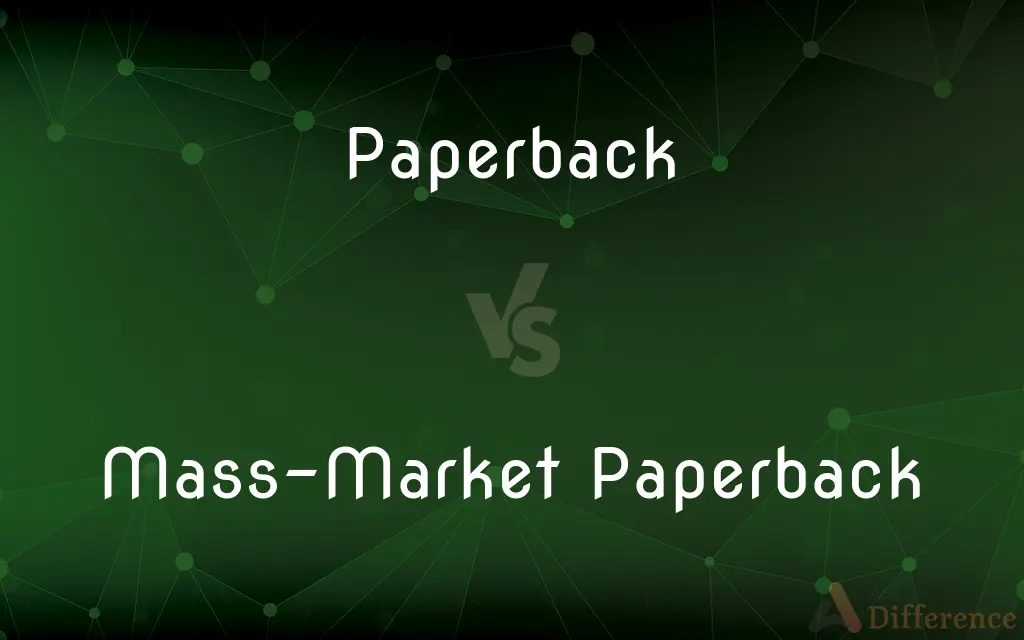Paperback vs. Mass-Market Paperback — What's the Difference?
By Tayyaba Rehman & Urooj Arif — Published on February 8, 2024
Paperback books have flexible covers; larger and more expensive. Mass-Market Paperback books are smaller, cheaper, and printed for a large audience.

Difference Between Paperback and Mass-Market Paperback
Table of Contents
ADVERTISEMENT
Key Differences
Paperback books feature flexible, paper-based covers and are often larger in size. Mass-Market Paperback books are smaller, usually pocket-sized, and made for widespread distribution.
Paperbacks are often printed in larger formats and contain higher quality paper and printing. Mass-Market Paperbacks are typically lower in print quality, reflecting their lower price point.
Paperbacks often cater to a more diverse market, including academic and niche topics. Mass-Market Paperbacks are usually focused on popular genres like romance, thriller, and fantasy.
Paperback books can be more durable and are often preferred for collections. Mass-Market Paperbacks are designed for convenience and affordability, not longevity.
Paperback editions are released after hardcover editions and before mass-market editions. Mass-Market Paperbacks are often released last, targeting readers looking for budget-friendly options.
ADVERTISEMENT
Comparison Chart
Size
Larger, varied dimensions
Smaller, pocket-sized
Quality
Higher quality paper and print
Lower quality, economical print
Price
Generally more expensive
Cheaper, affordable
Target Audience
Broader market, including academics
General public, popular genres
Durability
More durable covers and binding
Less durable, designed for one-time read
Compare with Definitions
Paperback
Released after the hardcover edition.
I waited for the paperback release of the book to save money.
Mass-Market Paperback
Printed on lower-quality paper to reduce costs.
The mass-market paperback felt flimsy but was very affordable.
Paperback
A book with a flexible, paper-based cover.
I prefer reading paperbacks as they are lighter and easier to carry around.
Mass-Market Paperback
Less durable but more economical than other editions.
I bought the mass-market paperback, knowing it wouldn’t last long.
Paperback
Caters to a diverse reading market, including academic texts.
The university bookstore mostly stocks paperbacks for students.
Mass-Market Paperback
A smaller, pocket-sized book edition.
Mass-market paperbacks are perfect for reading on the go.
Paperback
Often larger in size than mass-market editions.
The paperback edition of the novel had large, easy-to-read print.
Mass-Market Paperback
Focused on popular fiction and non-fiction genres.
Most bestsellers are available in mass-market paperback editions.
Paperback
Higher quality printing and paper than mass-market versions.
The illustrations in the paperback version were clearer and more vibrant.
Mass-Market Paperback
Designed for widespread distribution and sales.
You can find mass-market paperbacks in almost any bookstore.
Paperback
A book having a flexible paper binding.
Paperback
A book with flexible binding.
Paperback
(of a book) Having flexible binding.
Paperback
To issue or publish (a book) in a paperback edition.
Paperback
A book with paper covers; - contrasted with hardback or hardcover.
Paperback
Having a flexible binding; - of books. Contrasted to hardcover or hardbacked or hardbound.
Paperback
A book with paper covers
Paperback
(of books) having a flexible binding
Common Curiosities
What is a paperback book?
A paperback book is a book bound with a flexible paper cover, often larger in size and print quality than mass-market editions.
Can all books be found in paperback editions?
Most books, especially popular and mainstream titles, are released in paperback editions.
What distinguishes a mass-market paperback?
Mass-market paperbacks are smaller, cheaper editions of books, made for wide distribution and accessibility.
Are mass-market paperbacks only for fiction?
While popular in fiction, mass-market paperbacks also include non-fiction genres.
Are mass-market paperbacks durable?
Mass-market paperbacks are less durable due to their lower-quality paper and binding.
Why are paperbacks popular?
Paperbacks are popular due to their affordability, portability, and comfort in handling compared to hardcovers.
Why choose a paperback over a hardcover?
Paperbacks are chosen over hardcovers for their lower cost, lighter weight, and easier handling.
What makes mass-market paperbacks convenient?
Their small size and low cost make mass-market paperbacks convenient for travel and casual reading.
Why are mass-market paperbacks cheaper?
Mass-market paperbacks are cheaper due to their smaller size, lower-quality materials, and the economies of scale in printing.
Are paperbacks better for the environment?
Paperbacks can be more eco-friendly than hardcovers due to less material usage, but it depends on the production process.
Do paperbacks come in different sizes?
Yes, paperbacks can vary in size, often larger than mass-market paperbacks.
How long do paperback books last?
Paperbacks can last many years with proper care, though not as long as hardcovers.
Is the content in mass-market paperbacks different?
The content in mass-market paperbacks is usually the same as in other editions, but the formatting and typesetting may differ.
Are mass-market paperbacks available globally?
Yes, mass-market paperbacks are widely available globally, especially in popular bookstores and online retailers.
Do paperbacks have illustrations?
Paperbacks can include illustrations, often with better quality than in mass-market editions.
Share Your Discovery

Previous Comparison
World War I vs. World War II
Next Comparison
MicroSD Card vs. SD CardAuthor Spotlight
Written by
Tayyaba RehmanTayyaba Rehman is a distinguished writer, currently serving as a primary contributor to askdifference.com. As a researcher in semantics and etymology, Tayyaba's passion for the complexity of languages and their distinctions has found a perfect home on the platform. Tayyaba delves into the intricacies of language, distinguishing between commonly confused words and phrases, thereby providing clarity for readers worldwide.
Co-written by
Urooj ArifUrooj is a skilled content writer at Ask Difference, known for her exceptional ability to simplify complex topics into engaging and informative content. With a passion for research and a flair for clear, concise writing, she consistently delivers articles that resonate with our diverse audience.













































